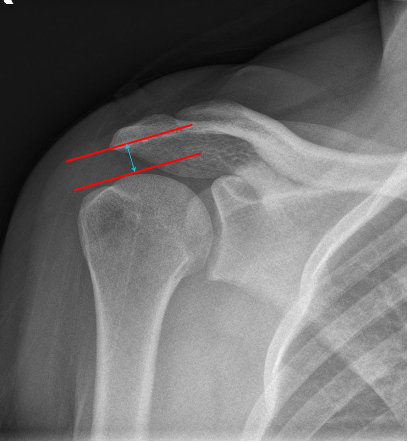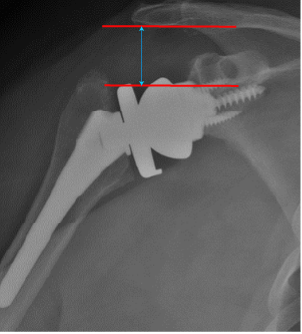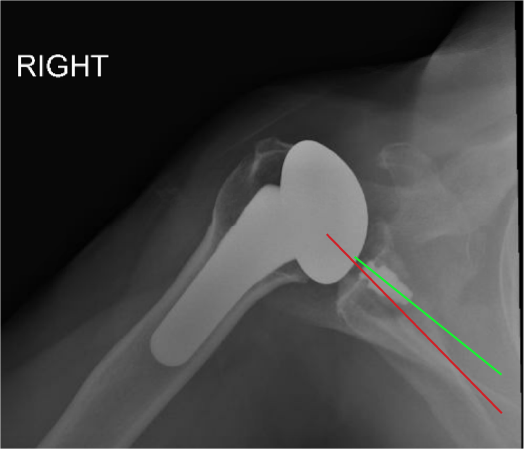POST-OPERATIVE RADIOGRAPHIC ASSESSMENT
The following section outlines the post-operative radiographic evaluation of patients who have undergone total shoulder arthroplasty. These measurements are useful in evaluating implant positioning, and identifying possible causes of pain, instability, or other issues following total shoulder arthroplasty.
Acromiohumeral Interval
The acromiohumeral interval is defined as the distance from the undersurface of the acromion to the top of the humeral head or prosthesis. In patients who have undergone hemiarthroplasty or anatomic total shoulder arthroplasty, decreased acromiohumeral interval with superior humeral head migration may be suggestive of rotator cuff insufficiency. Rotator cuff insufficiency is a common cause for revision surgery in those who have undergone hemiarthroplasty or anatomic total shoulder arthroplasty, and may also lead to osteolysis and component loosening in these patients.





- Draw a line tangent and parallel to the inferior aspect of the acromion process
- Draw a second line parallel to the first line tangent to the most superior aspect of the humerus or the most superior aspect of the humeral component.
- Measure the distance between the two parallel lines.
Acromiohumeral Offset
Acromiohumeral offset is defined as the distance between a line drawn along the lateral edge of the acromion and a line drawn along the lateral edge of the greater tuberosity. It is a marker of humeral lateralization. Humeral lateralization plays a role in deltoid tensioning and implant stability. An under-lateralized prosethesis can result in weakness due to poor deltoid tensioning as well as instability and dislocation. An over-lateralized prosthesis can result in acromial stress fracture, neurologic injury, deltoid insertional tendonitis, and persistent pain post-operatively.





- Draw vertical line tangent to the lateral edge of acromion
- Draw parallel line tangent to the lateral edge of the greater tuberosity
- Measure distance between the two lines
Humeral Tuberosity-head Height
Humeral tuberosity-head height is the distance between the superior most aspect of the humeral component and the footprint of the greater tuberosity.





- Draw a line tangent to the most superior aspect of the humeral component.
- Draw a second line parallel to the first tangent to the foot print of the greater tuberosity
- Measure the distance
Global Offset
Global offset is defined as the distance between a line tangent to the lateral edge of the base of the coracoid process and a parallel line tangent to the lateral edge of the greater tuberosity. Global offset is also a measure of lateralization which as previously mentioned plays a role in implant stability and joint function.





- Draw vertical line tangent to the lateral edge of the base of the coracoid process
- Draw parallel line tangent to the lateral edge of the greater tuberosity
- Measure distance between the two lines
Glenoid Offset
Glenoid offset is defined as the distance between a line along the lateral edge of the coracoid process and a vertical line passing through the region where the humeral and glenoid joint surfaces come in contact. This is a measure of glenoid component lateralization.





- Draw vertical line tangent to the lateral edge of the base of the coracoid process
- Draw parallel line tangent to the medial edge of the humeral head or humeral head prosthesis in an anatomic shoulder. In a reverse shoulder the line is tangent to lateral edge of the glenosphere.
- Measure distance between the two lines
Humeral Offset
Humeral offset is defined as the distance between the lateral edge of the greater tuberosity and the the region where the humeral and glenoid joint surfaces make contact. This is a measure of humeral component lateralization.





- Draw vertical line tangent to the lateral edge of the greater tuberosity
- Draw parallel line tangent to the medial edge of the humeral head or humeral prosthesis in an anatomic. In reverse draw a line tangent to the lateral edge of the glenosphere
- Measure distance between the two lines
Inclination (beta angle)
Inclination is a measure of how superiorly or inferiorly inclined the glenoid component is in relation to the supraspinatus fossa. In anatomic total shoulder arthroplasty, excessively superiorly inclined implants can result in greater sheer stress across the implant and subsequent osteolysis and component loosening. In reverse total shoulder arthroplasty particularly, superiorly inclined components can result in impingement, instability, decreased range of motion, and scapular notching.





- Draw a line parallel to the supraspinatus fossa line (red line)
- Draw a line perpendicular to supraspinatus fossa line that intersects inferior pole of glenoid (yellow line)
- Draw a line connecting the superior and inferior aspects of glenoid (green line)
- Measure the angle between the line perpendicular to the supraspinatus fossa line and the line connecting the superior and inferior pole of glenoid.
Components with central screw or post can measure the angle between the supraspinatus fossa line and a line parallel the central aspect of the central screw or post of implant. (blue line)
Version


- Draw a line parallel to the scapular body through the center of the glenoid vault (Friedman’s line – red line)
- Draw a line down the center of the central peg or screw (green line)
- Measure the angle between Friedman’s line and the line down the center of the central peg or screw.
